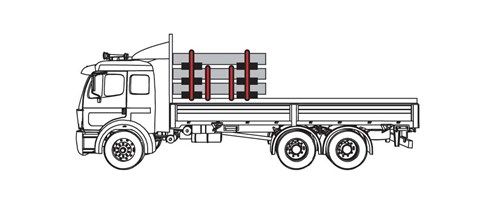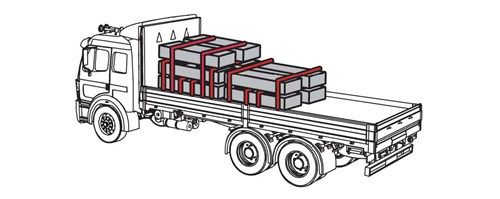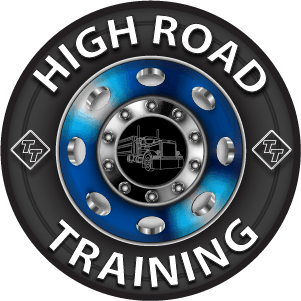Note: Your are not logged in. We can not keep your scores or track your progress unless you Register and Log In
Dressed Lumber and Similar Building Materials
Requirements for securing bundles in two or more tiers
There are four options for securing bundles of dressed lumber that are transported in two or more tiers. Choose one of the four.
Option #1:

To block side-to-side movement, block the bundles with stakes on the sides of the vehicle. Secure the bundles by tie-downs laid out over the top tier.
Option #2:

To block side-to-side movement, use blocking or high friction devices between the tiers. Secure the bundles by tie-downs laid out over the top tier, as outlined in Section 2.
High Friction Devices
- Friction mat
- Piece of wood with friction surface
- Cleated mat
- Other specialized equipment
Option #3:

Place bundles directly on top of other bundles or on spacers.
Tie-downs over the second tier of bundles or at 1.85 m (6 ft) above the trailer deck (whichever is greater).
Tie-downs for other multiple tiers not over 1.85 m (6 ft) above the trailer.
Tie-downs over the top tier of bundles with a minimum of 2 tie-downs over each top bundle longer than 1.52 m (5 ft).
Spacer Requirements
- The length of spacers must provide support to all pieces in the bottom row of the bundle.
- The width of each spacer must be equal or greater than the height.
- Spacers must provide good interlayer friction.
- If spacers are comprised of layers of material, the layers must be unitized or fastened together to ensure that the spacer performs as a single piece of material.
Option #4:

Secure the bundles by tie-downs over each tier of bundles in accordance with the general cargo securement requirements.
Use at least 2 tie-downs over each bundle on the top tier that is longer than 1.52 m (5 ft).
Suggestion to Increase Safety
Choose one of two options for stopping forward motion:

-
Option #1
Place bundles against bulkhead/front end structure.
-
Option #2
When different tiers need to be secured, use a combination of blocking equipment and tie-downs.
Multiple-Choice Questions:
Methods of securing building materials against forward motion include:
- These are all valid methods.
- Employing blocking equipment.
- Placing bundles against the bulkhead or front end.
- Using tiedowns.

-
Option #1
Place bundles against bulkhead/front end structure.
-
Option #2
When different tiers need to be secured, use a combination of blocking equipment and tiedowns.
When securing building materials, spacer requirements include all of the following except:
- The height of each spacer must be equal or greater than the width.
- The length of spacers must provide support to all pieces in the bottom row of the bundle.
- If spacers are comprised of layers of material, the layers must be unitized or fastened together to ensure that the spacer performs as a single piece of material.
- Spacers must provide good interlayer friction.
Spacer Requirements
- The length of spacers must provide support to all pieces in the bottom row of the bundle.
- The width of each spacer must be equal or greater than the height.
- Spacers must provide good interlayer friction.
- If spacers are comprised of layers of material, the layers must be unitized or fastened together to ensure that the spacer performs as a single piece of material.
When securing building materials, how many tiedowns are required for top tier bundles longer than 5 ft?
- 2
- It depends on weight
- 1
- 0
Tiedowns over the top tier of bundles with a minimum of 2 tiedowns over each top bundle longer than 1.52 m (5 ft).
High friction securement devices include:
- Friction mat
- Piece of wood with friction surface
- These can all be used for securement.
- Cleated mat
High Friction Devices
- Friction mat
- Piece of wood with friction surface
- Cleated mat
- Other specialized equipment
Complete!
You can Return To The Table Of Contents







 TT On Facebook
TT On Facebook